SPSS Project Report: Effectiveness Analysis of Leukemia Treatments
VerifiedAdded on 2020/02/03
|25
|5338
|47
Report
AI Summary
This SPSS project report examines the effectiveness of different treatment procedures for Leukemia. The study employed a longitudinal design over six weeks, using quantitative methods to assess the impact of a new therapy compared to traditional care. Participants were divided into intervention and control groups, with data collected at pre-intervention, post-intervention, and follow-up stages. The analysis utilized descriptive statistics, independent t-tests, Mann Whitney U tests, one-way ANOVA, and partial correlation to evaluate variables such as self-image index, number of relapses, and the relationship between weight and time. The results, presented through descriptive analysis and statistical tests, revealed significant differences between the intervention and control groups and provided insights into the impact of treatment procedures on patient outcomes. The study concludes with a discussion of the findings, limitations, and clinical applications, emphasizing the importance of statistical analysis in evaluating medical interventions.
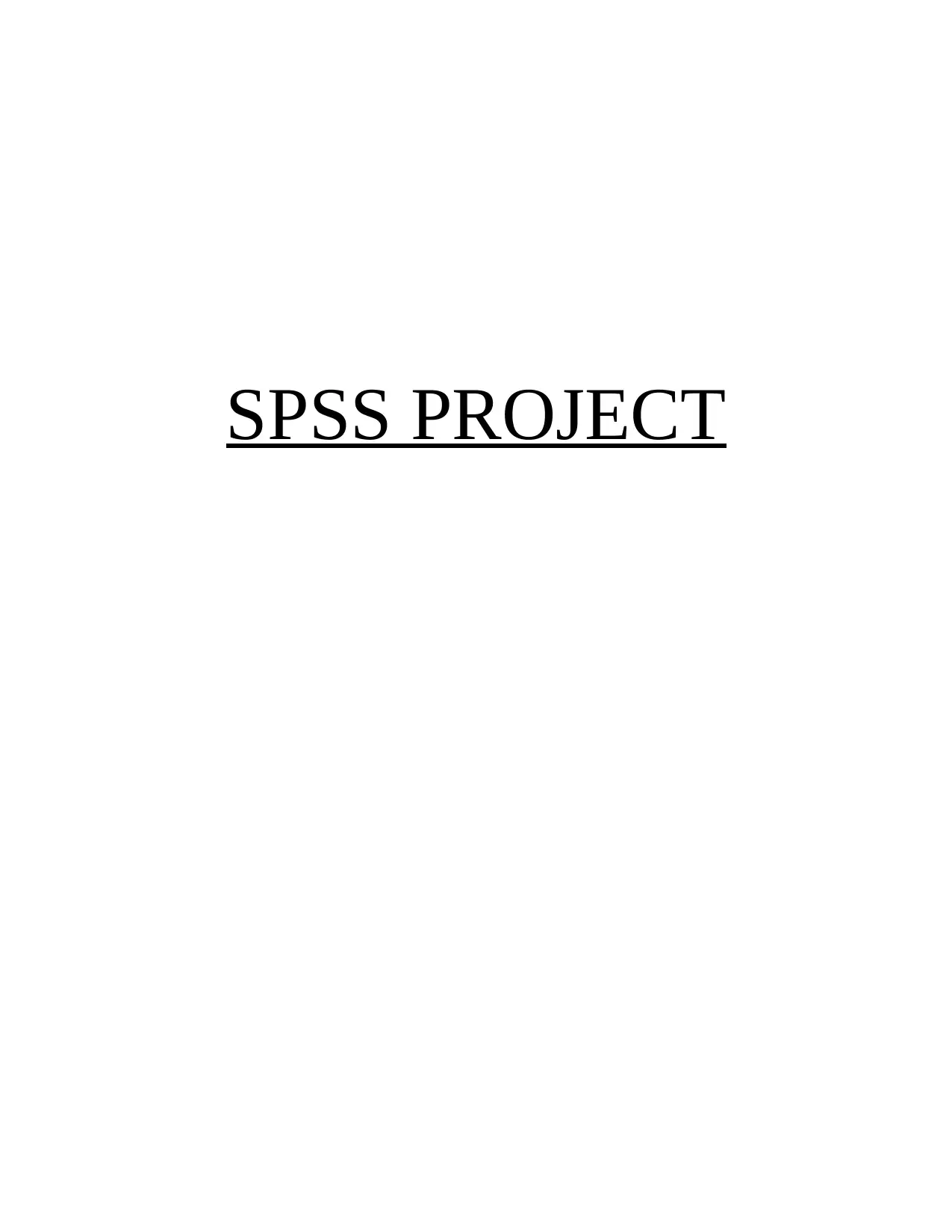
SPSS PROJECT
Paraphrase This Document
Need a fresh take? Get an instant paraphrase of this document with our AI Paraphraser
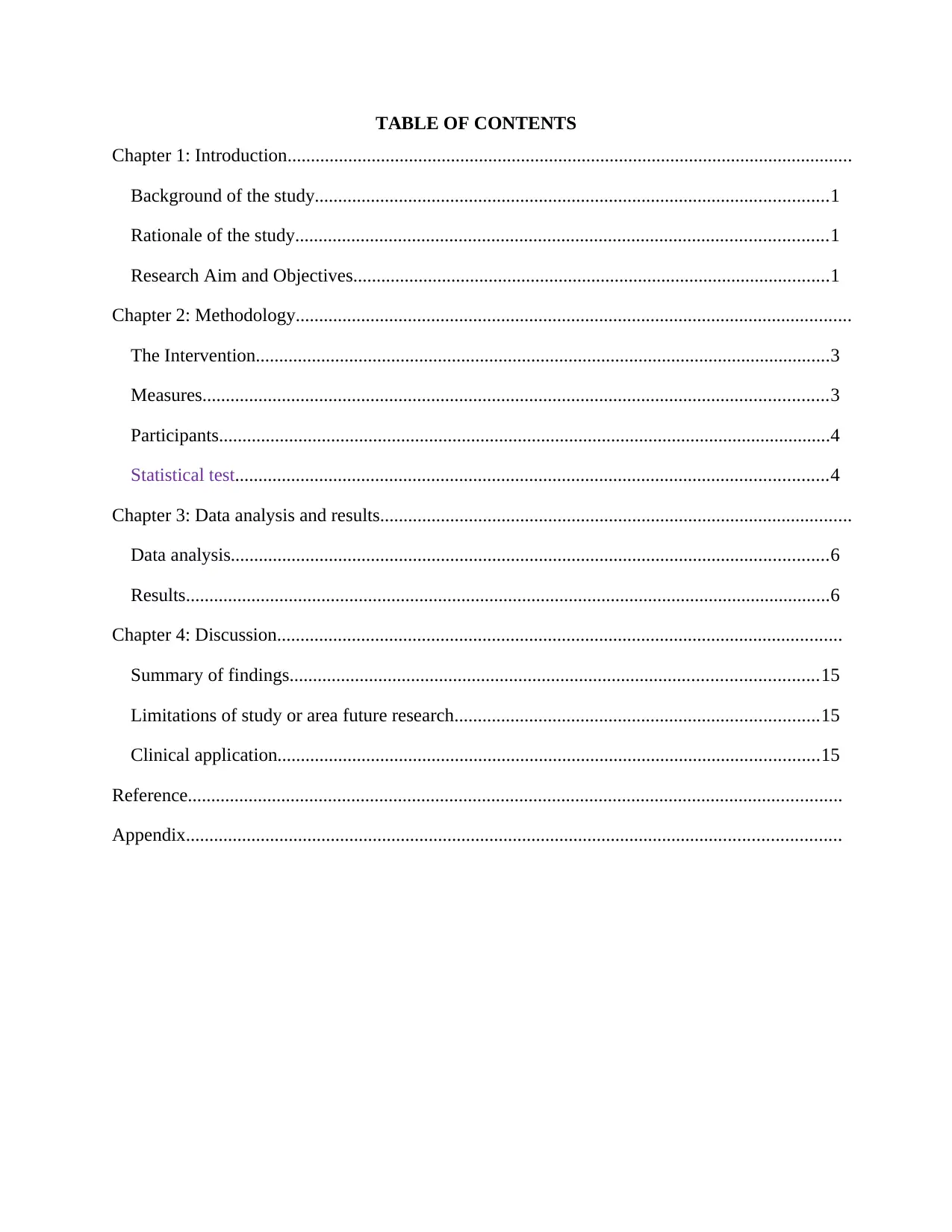
TABLE OF CONTENTS
Chapter 1: Introduction.........................................................................................................................
Background of the study..............................................................................................................1
Rationale of the study..................................................................................................................1
Research Aim and Objectives......................................................................................................1
Chapter 2: Methodology.......................................................................................................................
The Intervention...........................................................................................................................3
Measures......................................................................................................................................3
Participants...................................................................................................................................4
Statistical test...............................................................................................................................4
Chapter 3: Data analysis and results.....................................................................................................
Data analysis................................................................................................................................6
Results..........................................................................................................................................6
Chapter 4: Discussion.........................................................................................................................
Summary of findings.................................................................................................................15
Limitations of study or area future research..............................................................................15
Clinical application....................................................................................................................15
Reference............................................................................................................................................
Appendix............................................................................................................................................
Chapter 1: Introduction.........................................................................................................................
Background of the study..............................................................................................................1
Rationale of the study..................................................................................................................1
Research Aim and Objectives......................................................................................................1
Chapter 2: Methodology.......................................................................................................................
The Intervention...........................................................................................................................3
Measures......................................................................................................................................3
Participants...................................................................................................................................4
Statistical test...............................................................................................................................4
Chapter 3: Data analysis and results.....................................................................................................
Data analysis................................................................................................................................6
Results..........................................................................................................................................6
Chapter 4: Discussion.........................................................................................................................
Summary of findings.................................................................................................................15
Limitations of study or area future research..............................................................................15
Clinical application....................................................................................................................15
Reference............................................................................................................................................
Appendix............................................................................................................................................
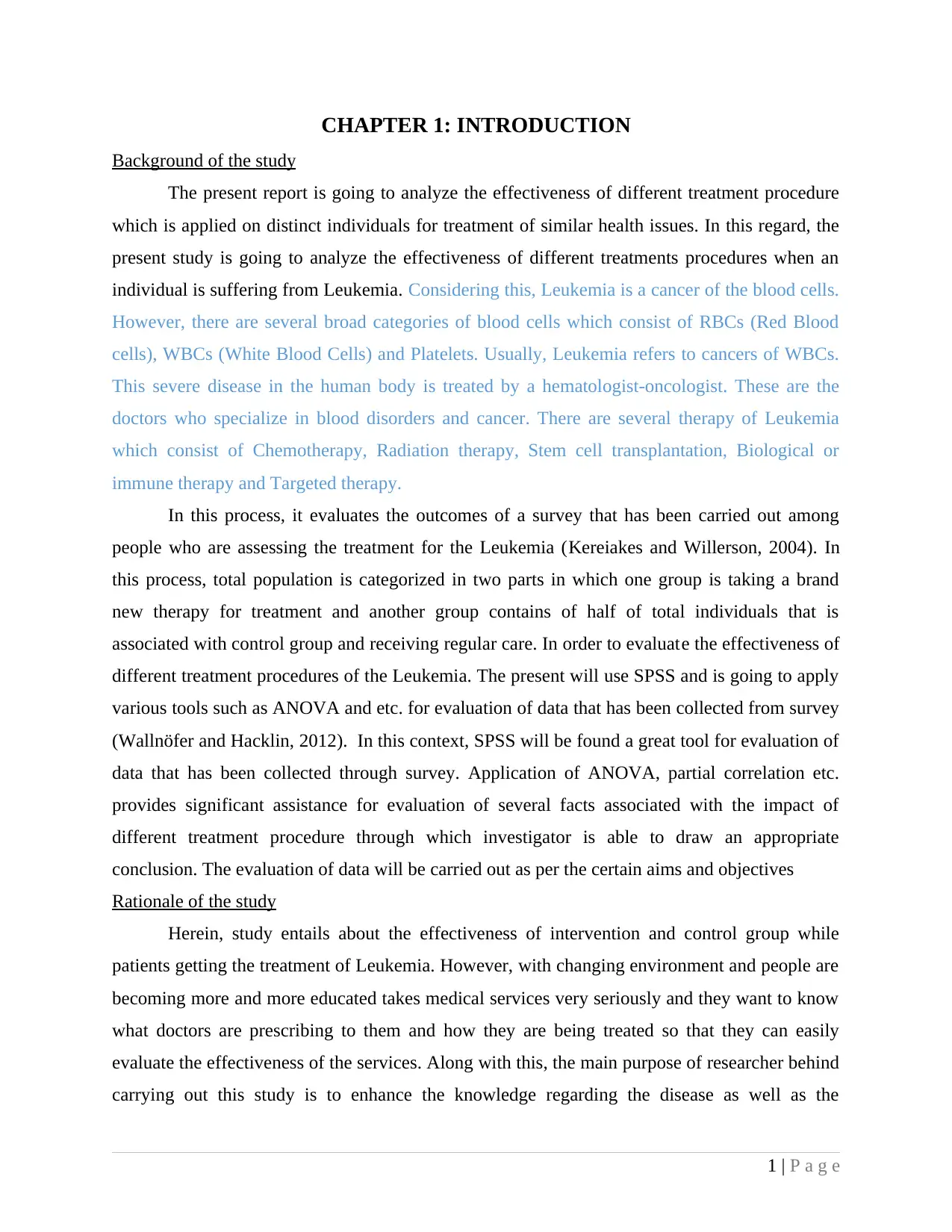
CHAPTER 1: INTRODUCTION
Background of the study
The present report is going to analyze the effectiveness of different treatment procedure
which is applied on distinct individuals for treatment of similar health issues. In this regard, the
present study is going to analyze the effectiveness of different treatments procedures when an
individual is suffering from Leukemia. Considering this, Leukemia is a cancer of the blood cells.
However, there are several broad categories of blood cells which consist of RBCs (Red Blood
cells), WBCs (White Blood Cells) and Platelets. Usually, Leukemia refers to cancers of WBCs.
This severe disease in the human body is treated by a hematologist-oncologist. These are the
doctors who specialize in blood disorders and cancer. There are several therapy of Leukemia
which consist of Chemotherapy, Radiation therapy, Stem cell transplantation, Biological or
immune therapy and Targeted therapy.
In this process, it evaluates the outcomes of a survey that has been carried out among
people who are assessing the treatment for the Leukemia (Kereiakes and Willerson, 2004). In
this process, total population is categorized in two parts in which one group is taking a brand
new therapy for treatment and another group contains of half of total individuals that is
associated with control group and receiving regular care. In order to evaluate the effectiveness of
different treatment procedures of the Leukemia. The present will use SPSS and is going to apply
various tools such as ANOVA and etc. for evaluation of data that has been collected from survey
(Wallnöfer and Hacklin, 2012). In this context, SPSS will be found a great tool for evaluation of
data that has been collected through survey. Application of ANOVA, partial correlation etc.
provides significant assistance for evaluation of several facts associated with the impact of
different treatment procedure through which investigator is able to draw an appropriate
conclusion. The evaluation of data will be carried out as per the certain aims and objectives
Rationale of the study
Herein, study entails about the effectiveness of intervention and control group while
patients getting the treatment of Leukemia. However, with changing environment and people are
becoming more and more educated takes medical services very seriously and they want to know
what doctors are prescribing to them and how they are being treated so that they can easily
evaluate the effectiveness of the services. Along with this, the main purpose of researcher behind
carrying out this study is to enhance the knowledge regarding the disease as well as the
1 | P a g e
Background of the study
The present report is going to analyze the effectiveness of different treatment procedure
which is applied on distinct individuals for treatment of similar health issues. In this regard, the
present study is going to analyze the effectiveness of different treatments procedures when an
individual is suffering from Leukemia. Considering this, Leukemia is a cancer of the blood cells.
However, there are several broad categories of blood cells which consist of RBCs (Red Blood
cells), WBCs (White Blood Cells) and Platelets. Usually, Leukemia refers to cancers of WBCs.
This severe disease in the human body is treated by a hematologist-oncologist. These are the
doctors who specialize in blood disorders and cancer. There are several therapy of Leukemia
which consist of Chemotherapy, Radiation therapy, Stem cell transplantation, Biological or
immune therapy and Targeted therapy.
In this process, it evaluates the outcomes of a survey that has been carried out among
people who are assessing the treatment for the Leukemia (Kereiakes and Willerson, 2004). In
this process, total population is categorized in two parts in which one group is taking a brand
new therapy for treatment and another group contains of half of total individuals that is
associated with control group and receiving regular care. In order to evaluate the effectiveness of
different treatment procedures of the Leukemia. The present will use SPSS and is going to apply
various tools such as ANOVA and etc. for evaluation of data that has been collected from survey
(Wallnöfer and Hacklin, 2012). In this context, SPSS will be found a great tool for evaluation of
data that has been collected through survey. Application of ANOVA, partial correlation etc.
provides significant assistance for evaluation of several facts associated with the impact of
different treatment procedure through which investigator is able to draw an appropriate
conclusion. The evaluation of data will be carried out as per the certain aims and objectives
Rationale of the study
Herein, study entails about the effectiveness of intervention and control group while
patients getting the treatment of Leukemia. However, with changing environment and people are
becoming more and more educated takes medical services very seriously and they want to know
what doctors are prescribing to them and how they are being treated so that they can easily
evaluate the effectiveness of the services. Along with this, the main purpose of researcher behind
carrying out this study is to enhance the knowledge regarding the disease as well as the
1 | P a g e
⊘ This is a preview!⊘
Do you want full access?
Subscribe today to unlock all pages.

Trusted by 1+ million students worldwide
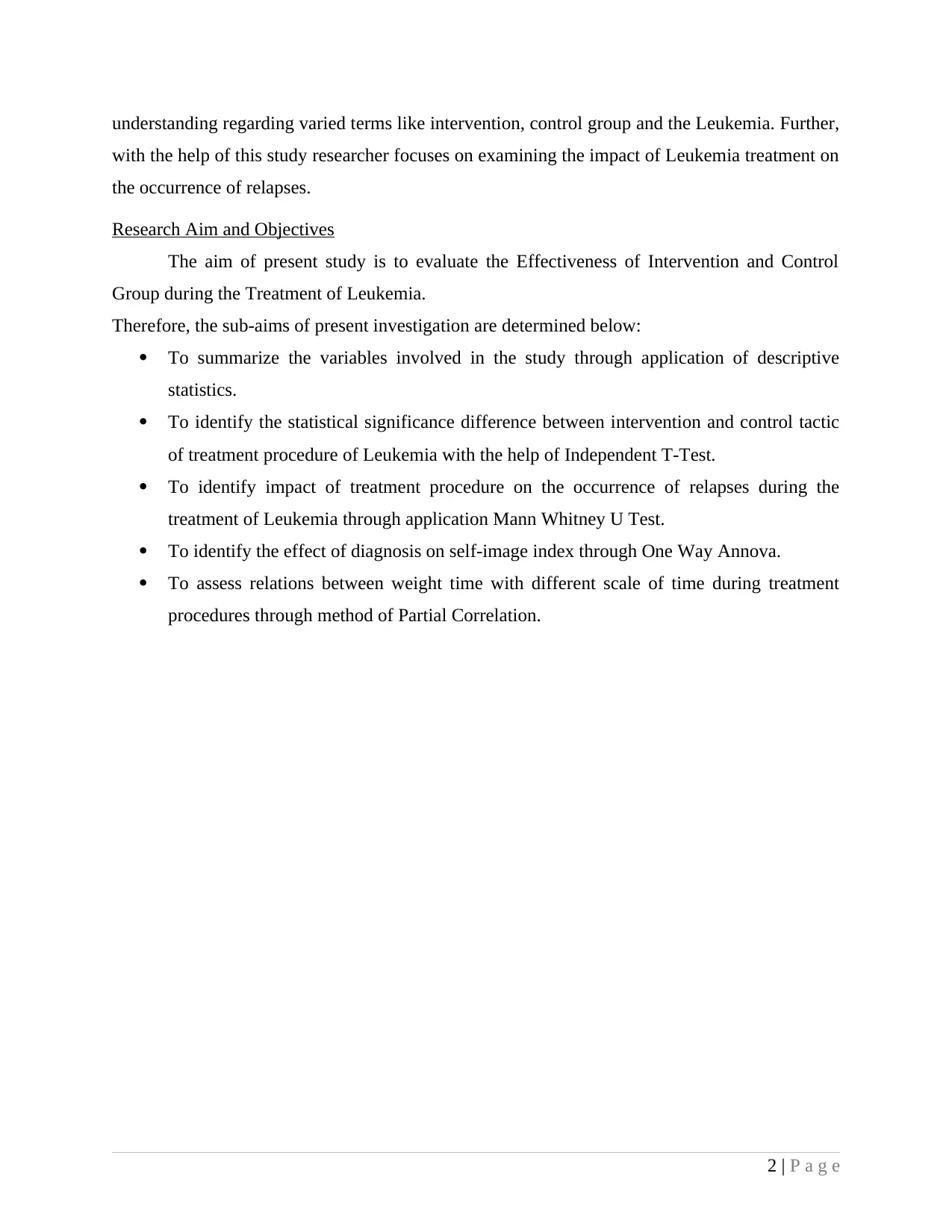
understanding regarding varied terms like intervention, control group and the Leukemia. Further,
with the help of this study researcher focuses on examining the impact of Leukemia treatment on
the occurrence of relapses.
Research Aim and Objectives
The aim of present study is to evaluate the Effectiveness of Intervention and Control
Group during the Treatment of Leukemia.
Therefore, the sub-aims of present investigation are determined below:
To summarize the variables involved in the study through application of descriptive
statistics.
To identify the statistical significance difference between intervention and control tactic
of treatment procedure of Leukemia with the help of Independent T-Test.
To identify impact of treatment procedure on the occurrence of relapses during the
treatment of Leukemia through application Mann Whitney U Test.
To identify the effect of diagnosis on self-image index through One Way Annova.
To assess relations between weight time with different scale of time during treatment
procedures through method of Partial Correlation.
2 | P a g e
with the help of this study researcher focuses on examining the impact of Leukemia treatment on
the occurrence of relapses.
Research Aim and Objectives
The aim of present study is to evaluate the Effectiveness of Intervention and Control
Group during the Treatment of Leukemia.
Therefore, the sub-aims of present investigation are determined below:
To summarize the variables involved in the study through application of descriptive
statistics.
To identify the statistical significance difference between intervention and control tactic
of treatment procedure of Leukemia with the help of Independent T-Test.
To identify impact of treatment procedure on the occurrence of relapses during the
treatment of Leukemia through application Mann Whitney U Test.
To identify the effect of diagnosis on self-image index through One Way Annova.
To assess relations between weight time with different scale of time during treatment
procedures through method of Partial Correlation.
2 | P a g e
Paraphrase This Document
Need a fresh take? Get an instant paraphrase of this document with our AI Paraphraser
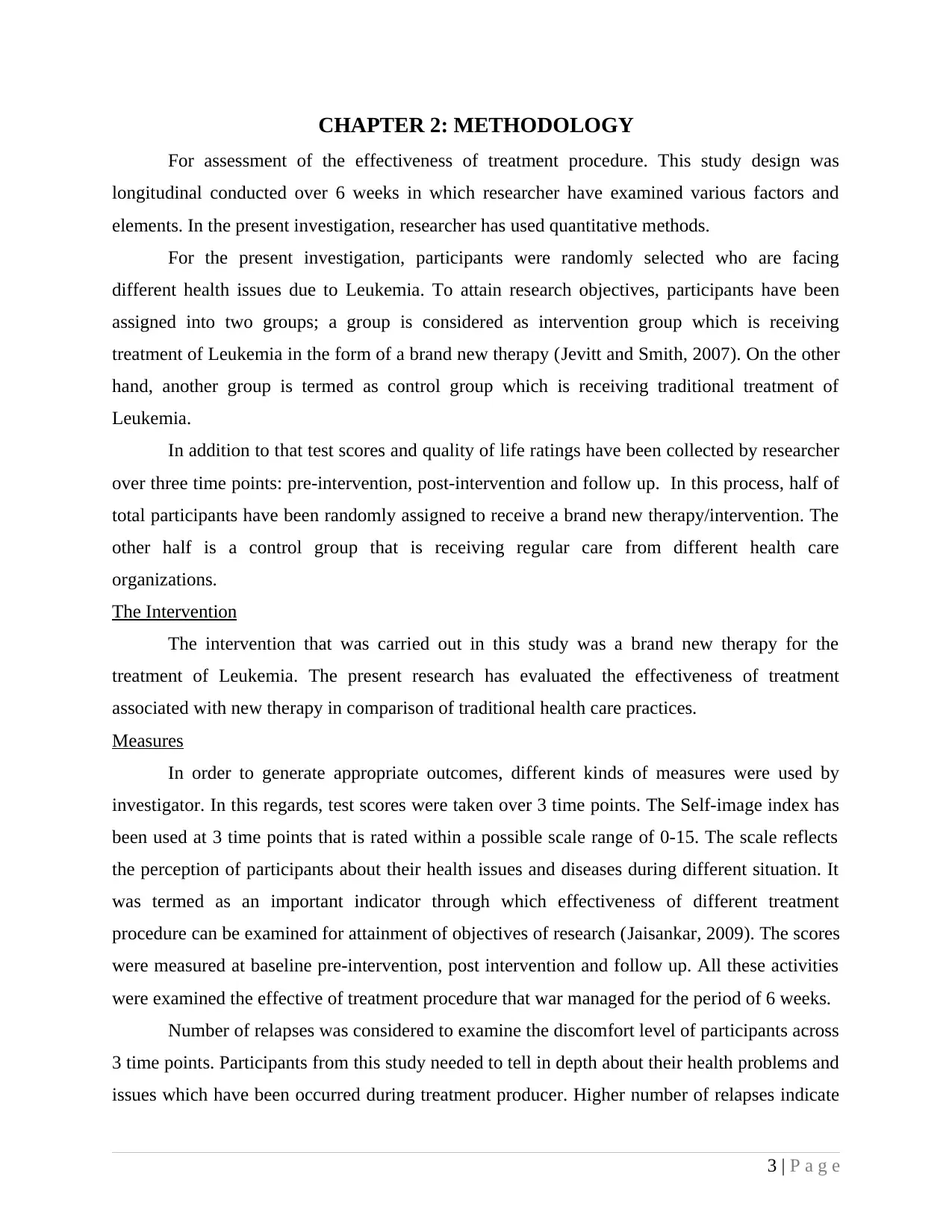
CHAPTER 2: METHODOLOGY
For assessment of the effectiveness of treatment procedure. This study design was
longitudinal conducted over 6 weeks in which researcher have examined various factors and
elements. In the present investigation, researcher has used quantitative methods.
For the present investigation, participants were randomly selected who are facing
different health issues due to Leukemia. To attain research objectives, participants have been
assigned into two groups; a group is considered as intervention group which is receiving
treatment of Leukemia in the form of a brand new therapy (Jevitt and Smith, 2007). On the other
hand, another group is termed as control group which is receiving traditional treatment of
Leukemia.
In addition to that test scores and quality of life ratings have been collected by researcher
over three time points: pre-intervention, post-intervention and follow up. In this process, half of
total participants have been randomly assigned to receive a brand new therapy/intervention. The
other half is a control group that is receiving regular care from different health care
organizations.
The Intervention
The intervention that was carried out in this study was a brand new therapy for the
treatment of Leukemia. The present research has evaluated the effectiveness of treatment
associated with new therapy in comparison of traditional health care practices.
Measures
In order to generate appropriate outcomes, different kinds of measures were used by
investigator. In this regards, test scores were taken over 3 time points. The Self-image index has
been used at 3 time points that is rated within a possible scale range of 0-15. The scale reflects
the perception of participants about their health issues and diseases during different situation. It
was termed as an important indicator through which effectiveness of different treatment
procedure can be examined for attainment of objectives of research (Jaisankar, 2009). The scores
were measured at baseline pre-intervention, post intervention and follow up. All these activities
were examined the effective of treatment procedure that war managed for the period of 6 weeks.
Number of relapses was considered to examine the discomfort level of participants across
3 time points. Participants from this study needed to tell in depth about their health problems and
issues which have been occurred during treatment producer. Higher number of relapses indicate
3 | P a g e
For assessment of the effectiveness of treatment procedure. This study design was
longitudinal conducted over 6 weeks in which researcher have examined various factors and
elements. In the present investigation, researcher has used quantitative methods.
For the present investigation, participants were randomly selected who are facing
different health issues due to Leukemia. To attain research objectives, participants have been
assigned into two groups; a group is considered as intervention group which is receiving
treatment of Leukemia in the form of a brand new therapy (Jevitt and Smith, 2007). On the other
hand, another group is termed as control group which is receiving traditional treatment of
Leukemia.
In addition to that test scores and quality of life ratings have been collected by researcher
over three time points: pre-intervention, post-intervention and follow up. In this process, half of
total participants have been randomly assigned to receive a brand new therapy/intervention. The
other half is a control group that is receiving regular care from different health care
organizations.
The Intervention
The intervention that was carried out in this study was a brand new therapy for the
treatment of Leukemia. The present research has evaluated the effectiveness of treatment
associated with new therapy in comparison of traditional health care practices.
Measures
In order to generate appropriate outcomes, different kinds of measures were used by
investigator. In this regards, test scores were taken over 3 time points. The Self-image index has
been used at 3 time points that is rated within a possible scale range of 0-15. The scale reflects
the perception of participants about their health issues and diseases during different situation. It
was termed as an important indicator through which effectiveness of different treatment
procedure can be examined for attainment of objectives of research (Jaisankar, 2009). The scores
were measured at baseline pre-intervention, post intervention and follow up. All these activities
were examined the effective of treatment procedure that war managed for the period of 6 weeks.
Number of relapses was considered to examine the discomfort level of participants across
3 time points. Participants from this study needed to tell in depth about their health problems and
issues which have been occurred during treatment producer. Higher number of relapses indicate
3 | P a g e
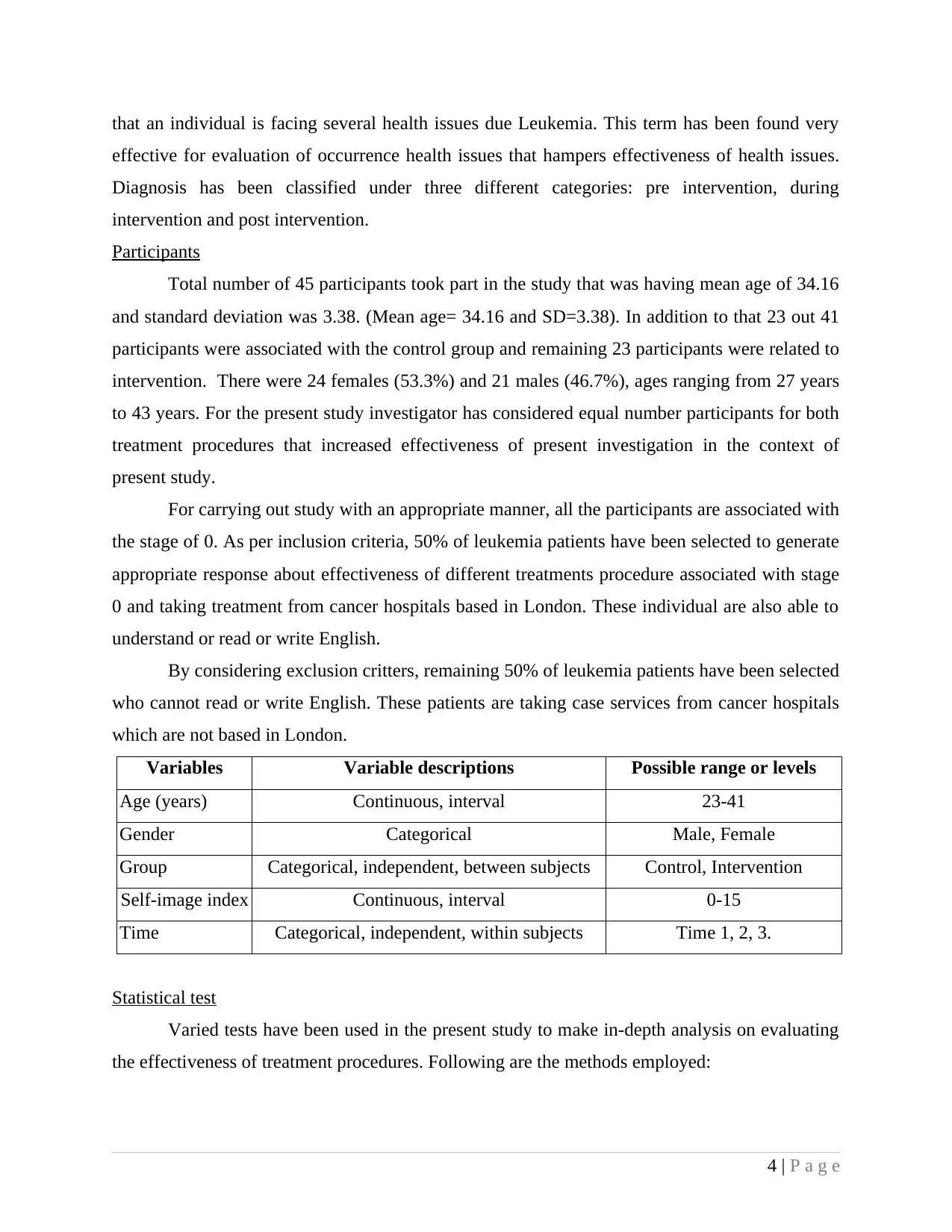
that an individual is facing several health issues due Leukemia. This term has been found very
effective for evaluation of occurrence health issues that hampers effectiveness of health issues.
Diagnosis has been classified under three different categories: pre intervention, during
intervention and post intervention.
Participants
Total number of 45 participants took part in the study that was having mean age of 34.16
and standard deviation was 3.38. (Mean age= 34.16 and SD=3.38). In addition to that 23 out 41
participants were associated with the control group and remaining 23 participants were related to
intervention. There were 24 females (53.3%) and 21 males (46.7%), ages ranging from 27 years
to 43 years. For the present study investigator has considered equal number participants for both
treatment procedures that increased effectiveness of present investigation in the context of
present study.
For carrying out study with an appropriate manner, all the participants are associated with
the stage of 0. As per inclusion criteria, 50% of leukemia patients have been selected to generate
appropriate response about effectiveness of different treatments procedure associated with stage
0 and taking treatment from cancer hospitals based in London. These individual are also able to
understand or read or write English.
By considering exclusion critters, remaining 50% of leukemia patients have been selected
who cannot read or write English. These patients are taking case services from cancer hospitals
which are not based in London.
Variables Variable descriptions Possible range or levels
Age (years) Continuous, interval 23-41
Gender Categorical Male, Female
Group Categorical, independent, between subjects Control, Intervention
Self-image index Continuous, interval 0-15
Time Categorical, independent, within subjects Time 1, 2, 3.
Statistical test
Varied tests have been used in the present study to make in-depth analysis on evaluating
the effectiveness of treatment procedures. Following are the methods employed:
4 | P a g e
effective for evaluation of occurrence health issues that hampers effectiveness of health issues.
Diagnosis has been classified under three different categories: pre intervention, during
intervention and post intervention.
Participants
Total number of 45 participants took part in the study that was having mean age of 34.16
and standard deviation was 3.38. (Mean age= 34.16 and SD=3.38). In addition to that 23 out 41
participants were associated with the control group and remaining 23 participants were related to
intervention. There were 24 females (53.3%) and 21 males (46.7%), ages ranging from 27 years
to 43 years. For the present study investigator has considered equal number participants for both
treatment procedures that increased effectiveness of present investigation in the context of
present study.
For carrying out study with an appropriate manner, all the participants are associated with
the stage of 0. As per inclusion criteria, 50% of leukemia patients have been selected to generate
appropriate response about effectiveness of different treatments procedure associated with stage
0 and taking treatment from cancer hospitals based in London. These individual are also able to
understand or read or write English.
By considering exclusion critters, remaining 50% of leukemia patients have been selected
who cannot read or write English. These patients are taking case services from cancer hospitals
which are not based in London.
Variables Variable descriptions Possible range or levels
Age (years) Continuous, interval 23-41
Gender Categorical Male, Female
Group Categorical, independent, between subjects Control, Intervention
Self-image index Continuous, interval 0-15
Time Categorical, independent, within subjects Time 1, 2, 3.
Statistical test
Varied tests have been used in the present study to make in-depth analysis on evaluating
the effectiveness of treatment procedures. Following are the methods employed:
4 | P a g e
⊘ This is a preview!⊘
Do you want full access?
Subscribe today to unlock all pages.

Trusted by 1+ million students worldwide
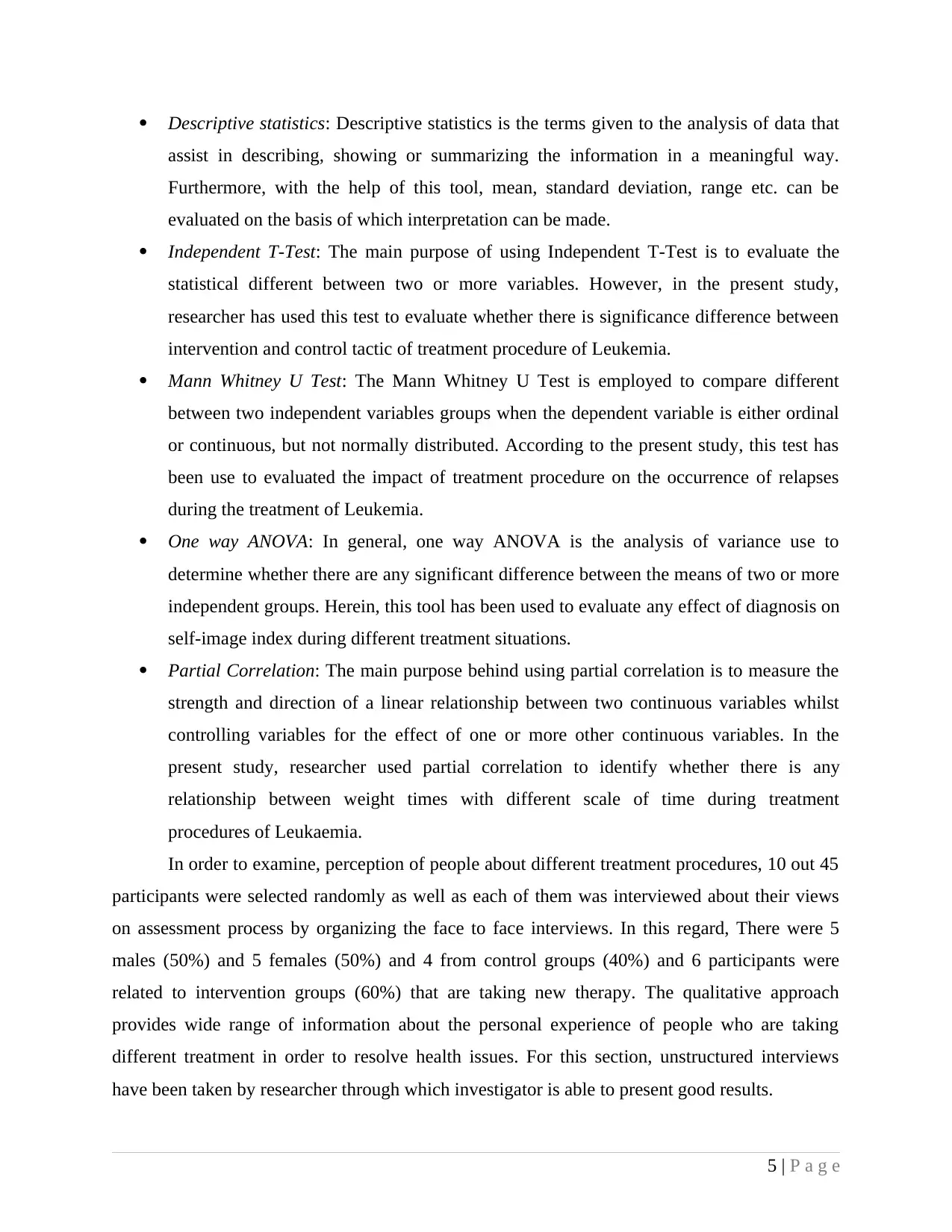
Descriptive statistics: Descriptive statistics is the terms given to the analysis of data that
assist in describing, showing or summarizing the information in a meaningful way.
Furthermore, with the help of this tool, mean, standard deviation, range etc. can be
evaluated on the basis of which interpretation can be made.
Independent T-Test: The main purpose of using Independent T-Test is to evaluate the
statistical different between two or more variables. However, in the present study,
researcher has used this test to evaluate whether there is significance difference between
intervention and control tactic of treatment procedure of Leukemia.
Mann Whitney U Test: The Mann Whitney U Test is employed to compare different
between two independent variables groups when the dependent variable is either ordinal
or continuous, but not normally distributed. According to the present study, this test has
been use to evaluated the impact of treatment procedure on the occurrence of relapses
during the treatment of Leukemia.
One way ANOVA: In general, one way ANOVA is the analysis of variance use to
determine whether there are any significant difference between the means of two or more
independent groups. Herein, this tool has been used to evaluate any effect of diagnosis on
self-image index during different treatment situations.
Partial Correlation: The main purpose behind using partial correlation is to measure the
strength and direction of a linear relationship between two continuous variables whilst
controlling variables for the effect of one or more other continuous variables. In the
present study, researcher used partial correlation to identify whether there is any
relationship between weight times with different scale of time during treatment
procedures of Leukaemia.
In order to examine, perception of people about different treatment procedures, 10 out 45
participants were selected randomly as well as each of them was interviewed about their views
on assessment process by organizing the face to face interviews. In this regard, There were 5
males (50%) and 5 females (50%) and 4 from control groups (40%) and 6 participants were
related to intervention groups (60%) that are taking new therapy. The qualitative approach
provides wide range of information about the personal experience of people who are taking
different treatment in order to resolve health issues. For this section, unstructured interviews
have been taken by researcher through which investigator is able to present good results.
5 | P a g e
assist in describing, showing or summarizing the information in a meaningful way.
Furthermore, with the help of this tool, mean, standard deviation, range etc. can be
evaluated on the basis of which interpretation can be made.
Independent T-Test: The main purpose of using Independent T-Test is to evaluate the
statistical different between two or more variables. However, in the present study,
researcher has used this test to evaluate whether there is significance difference between
intervention and control tactic of treatment procedure of Leukemia.
Mann Whitney U Test: The Mann Whitney U Test is employed to compare different
between two independent variables groups when the dependent variable is either ordinal
or continuous, but not normally distributed. According to the present study, this test has
been use to evaluated the impact of treatment procedure on the occurrence of relapses
during the treatment of Leukemia.
One way ANOVA: In general, one way ANOVA is the analysis of variance use to
determine whether there are any significant difference between the means of two or more
independent groups. Herein, this tool has been used to evaluate any effect of diagnosis on
self-image index during different treatment situations.
Partial Correlation: The main purpose behind using partial correlation is to measure the
strength and direction of a linear relationship between two continuous variables whilst
controlling variables for the effect of one or more other continuous variables. In the
present study, researcher used partial correlation to identify whether there is any
relationship between weight times with different scale of time during treatment
procedures of Leukaemia.
In order to examine, perception of people about different treatment procedures, 10 out 45
participants were selected randomly as well as each of them was interviewed about their views
on assessment process by organizing the face to face interviews. In this regard, There were 5
males (50%) and 5 females (50%) and 4 from control groups (40%) and 6 participants were
related to intervention groups (60%) that are taking new therapy. The qualitative approach
provides wide range of information about the personal experience of people who are taking
different treatment in order to resolve health issues. For this section, unstructured interviews
have been taken by researcher through which investigator is able to present good results.
5 | P a g e
Paraphrase This Document
Need a fresh take? Get an instant paraphrase of this document with our AI Paraphraser
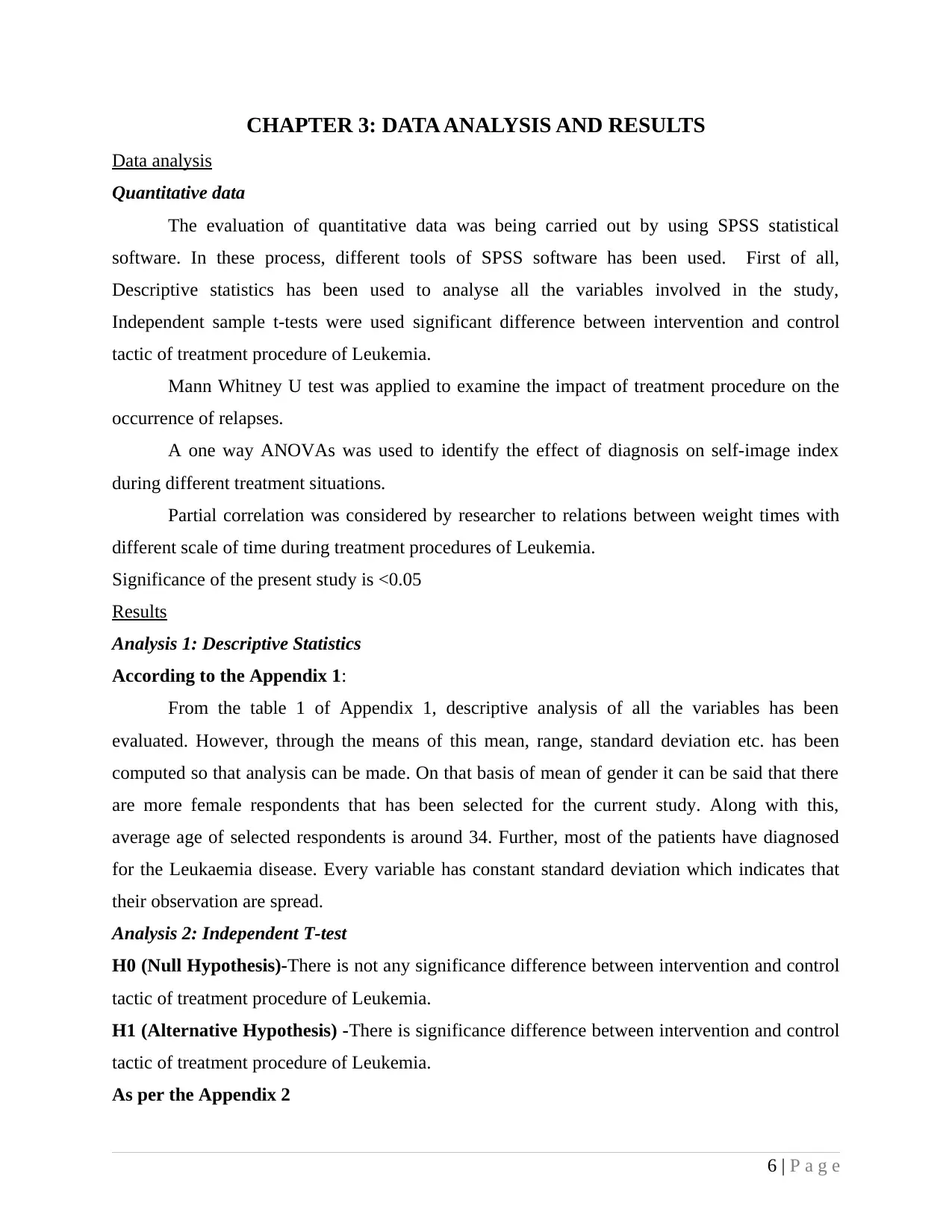
CHAPTER 3: DATA ANALYSIS AND RESULTS
Data analysis
Quantitative data
The evaluation of quantitative data was being carried out by using SPSS statistical
software. In these process, different tools of SPSS software has been used. First of all,
Descriptive statistics has been used to analyse all the variables involved in the study,
Independent sample t-tests were used significant difference between intervention and control
tactic of treatment procedure of Leukemia.
Mann Whitney U test was applied to examine the impact of treatment procedure on the
occurrence of relapses.
A one way ANOVAs was used to identify the effect of diagnosis on self-image index
during different treatment situations.
Partial correlation was considered by researcher to relations between weight times with
different scale of time during treatment procedures of Leukemia.
Significance of the present study is <0.05
Results
Analysis 1: Descriptive Statistics
According to the Appendix 1:
From the table 1 of Appendix 1, descriptive analysis of all the variables has been
evaluated. However, through the means of this mean, range, standard deviation etc. has been
computed so that analysis can be made. On that basis of mean of gender it can be said that there
are more female respondents that has been selected for the current study. Along with this,
average age of selected respondents is around 34. Further, most of the patients have diagnosed
for the Leukaemia disease. Every variable has constant standard deviation which indicates that
their observation are spread.
Analysis 2: Independent T-test
H0 (Null Hypothesis)-There is not any significance difference between intervention and control
tactic of treatment procedure of Leukemia.
H1 (Alternative Hypothesis) -There is significance difference between intervention and control
tactic of treatment procedure of Leukemia.
As per the Appendix 2
6 | P a g e
Data analysis
Quantitative data
The evaluation of quantitative data was being carried out by using SPSS statistical
software. In these process, different tools of SPSS software has been used. First of all,
Descriptive statistics has been used to analyse all the variables involved in the study,
Independent sample t-tests were used significant difference between intervention and control
tactic of treatment procedure of Leukemia.
Mann Whitney U test was applied to examine the impact of treatment procedure on the
occurrence of relapses.
A one way ANOVAs was used to identify the effect of diagnosis on self-image index
during different treatment situations.
Partial correlation was considered by researcher to relations between weight times with
different scale of time during treatment procedures of Leukemia.
Significance of the present study is <0.05
Results
Analysis 1: Descriptive Statistics
According to the Appendix 1:
From the table 1 of Appendix 1, descriptive analysis of all the variables has been
evaluated. However, through the means of this mean, range, standard deviation etc. has been
computed so that analysis can be made. On that basis of mean of gender it can be said that there
are more female respondents that has been selected for the current study. Along with this,
average age of selected respondents is around 34. Further, most of the patients have diagnosed
for the Leukaemia disease. Every variable has constant standard deviation which indicates that
their observation are spread.
Analysis 2: Independent T-test
H0 (Null Hypothesis)-There is not any significance difference between intervention and control
tactic of treatment procedure of Leukemia.
H1 (Alternative Hypothesis) -There is significance difference between intervention and control
tactic of treatment procedure of Leukemia.
As per the Appendix 2
6 | P a g e
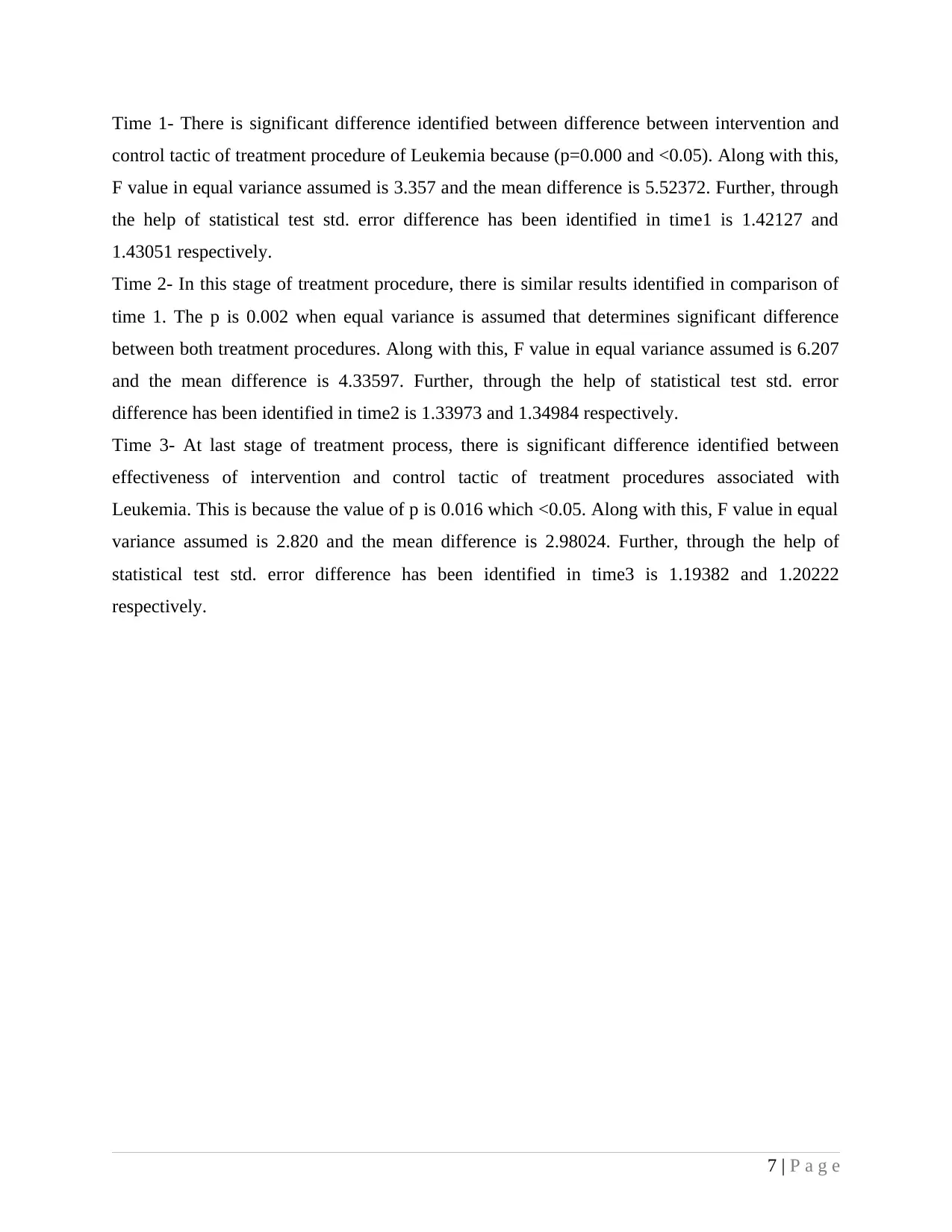
Time 1- There is significant difference identified between difference between intervention and
control tactic of treatment procedure of Leukemia because (p=0.000 and <0.05). Along with this,
F value in equal variance assumed is 3.357 and the mean difference is 5.52372. Further, through
the help of statistical test std. error difference has been identified in time1 is 1.42127 and
1.43051 respectively.
Time 2- In this stage of treatment procedure, there is similar results identified in comparison of
time 1. The p is 0.002 when equal variance is assumed that determines significant difference
between both treatment procedures. Along with this, F value in equal variance assumed is 6.207
and the mean difference is 4.33597. Further, through the help of statistical test std. error
difference has been identified in time2 is 1.33973 and 1.34984 respectively.
Time 3- At last stage of treatment process, there is significant difference identified between
effectiveness of intervention and control tactic of treatment procedures associated with
Leukemia. This is because the value of p is 0.016 which <0.05. Along with this, F value in equal
variance assumed is 2.820 and the mean difference is 2.98024. Further, through the help of
statistical test std. error difference has been identified in time3 is 1.19382 and 1.20222
respectively.
7 | P a g e
control tactic of treatment procedure of Leukemia because (p=0.000 and <0.05). Along with this,
F value in equal variance assumed is 3.357 and the mean difference is 5.52372. Further, through
the help of statistical test std. error difference has been identified in time1 is 1.42127 and
1.43051 respectively.
Time 2- In this stage of treatment procedure, there is similar results identified in comparison of
time 1. The p is 0.002 when equal variance is assumed that determines significant difference
between both treatment procedures. Along with this, F value in equal variance assumed is 6.207
and the mean difference is 4.33597. Further, through the help of statistical test std. error
difference has been identified in time2 is 1.33973 and 1.34984 respectively.
Time 3- At last stage of treatment process, there is significant difference identified between
effectiveness of intervention and control tactic of treatment procedures associated with
Leukemia. This is because the value of p is 0.016 which <0.05. Along with this, F value in equal
variance assumed is 2.820 and the mean difference is 2.98024. Further, through the help of
statistical test std. error difference has been identified in time3 is 1.19382 and 1.20222
respectively.
7 | P a g e
⊘ This is a preview!⊘
Do you want full access?
Subscribe today to unlock all pages.

Trusted by 1+ million students worldwide
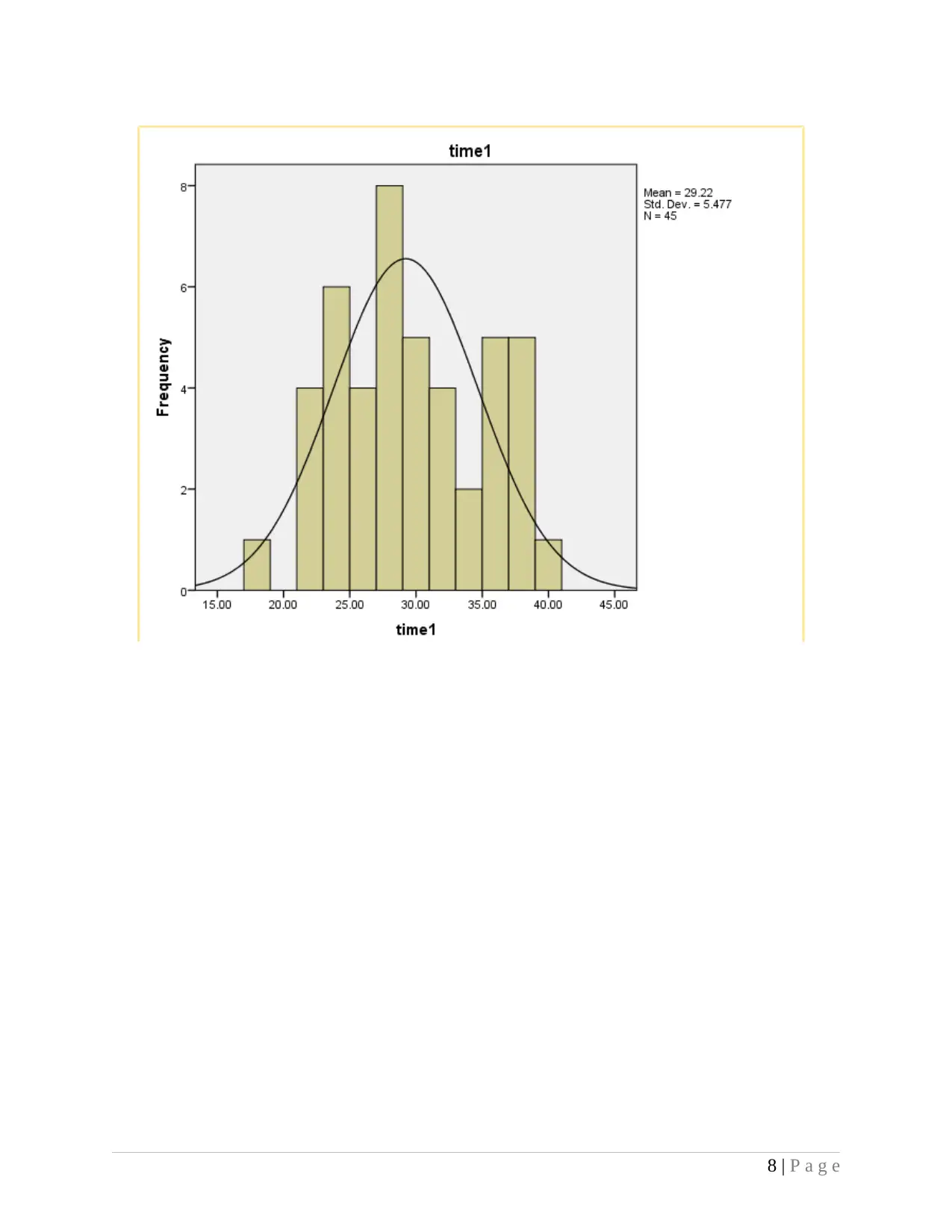
8 | P a g e
Paraphrase This Document
Need a fresh take? Get an instant paraphrase of this document with our AI Paraphraser
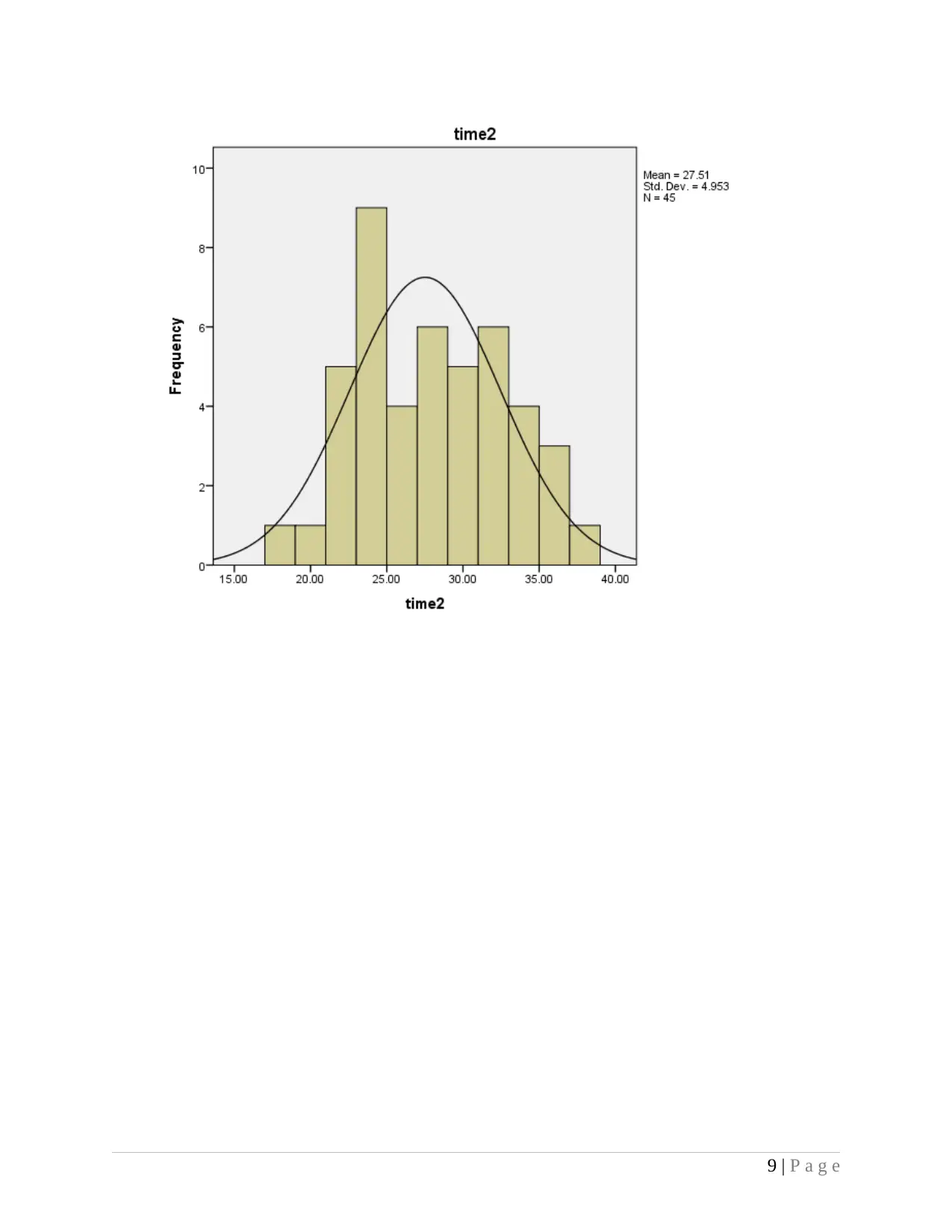
9 | P a g e
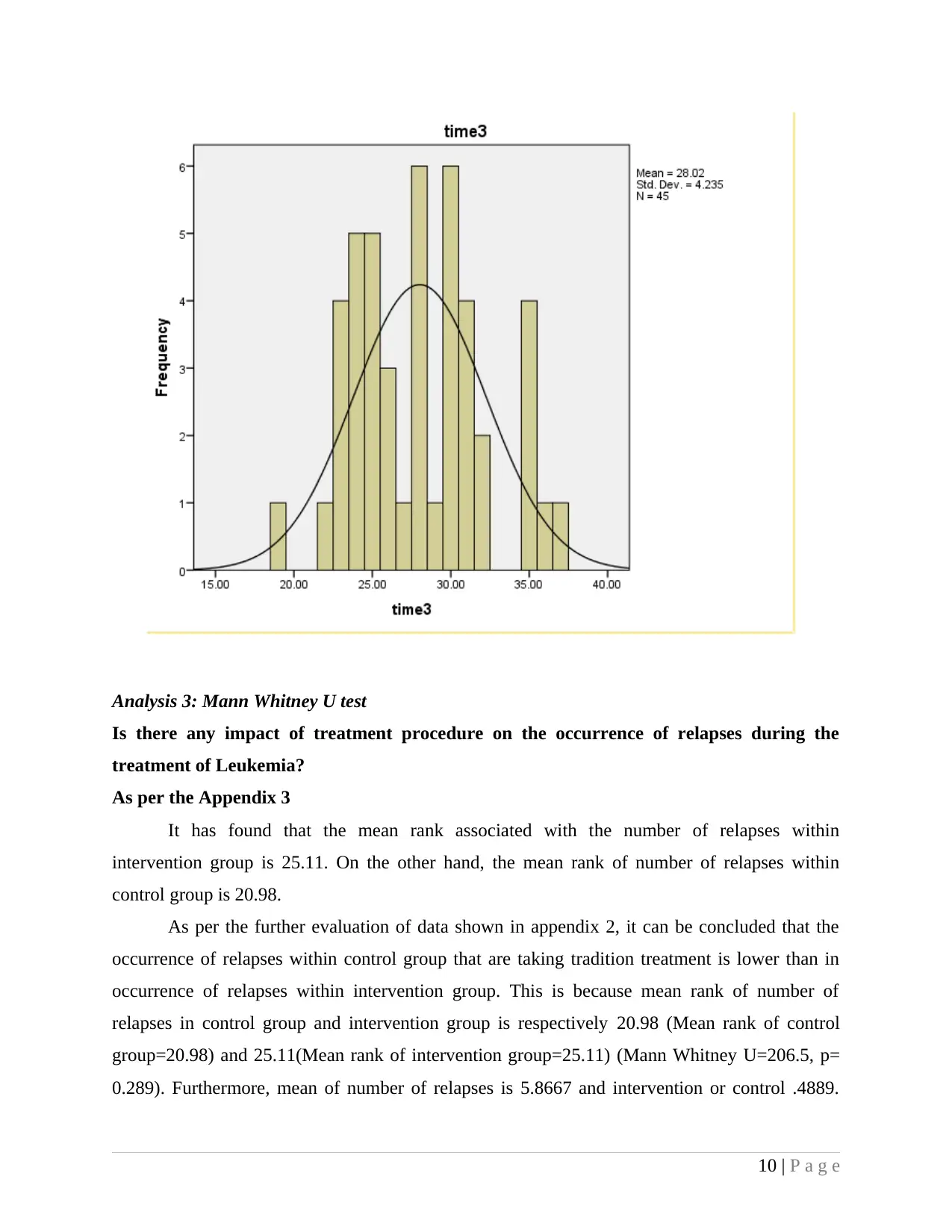
Analysis 3: Mann Whitney U test
Is there any impact of treatment procedure on the occurrence of relapses during the
treatment of Leukemia?
As per the Appendix 3
It has found that the mean rank associated with the number of relapses within
intervention group is 25.11. On the other hand, the mean rank of number of relapses within
control group is 20.98.
As per the further evaluation of data shown in appendix 2, it can be concluded that the
occurrence of relapses within control group that are taking tradition treatment is lower than in
occurrence of relapses within intervention group. This is because mean rank of number of
relapses in control group and intervention group is respectively 20.98 (Mean rank of control
group=20.98) and 25.11(Mean rank of intervention group=25.11) (Mann Whitney U=206.5, p=
0.289). Furthermore, mean of number of relapses is 5.8667 and intervention or control .4889.
10 | P a g e
Is there any impact of treatment procedure on the occurrence of relapses during the
treatment of Leukemia?
As per the Appendix 3
It has found that the mean rank associated with the number of relapses within
intervention group is 25.11. On the other hand, the mean rank of number of relapses within
control group is 20.98.
As per the further evaluation of data shown in appendix 2, it can be concluded that the
occurrence of relapses within control group that are taking tradition treatment is lower than in
occurrence of relapses within intervention group. This is because mean rank of number of
relapses in control group and intervention group is respectively 20.98 (Mean rank of control
group=20.98) and 25.11(Mean rank of intervention group=25.11) (Mann Whitney U=206.5, p=
0.289). Furthermore, mean of number of relapses is 5.8667 and intervention or control .4889.
10 | P a g e
⊘ This is a preview!⊘
Do you want full access?
Subscribe today to unlock all pages.

Trusted by 1+ million students worldwide
1 out of 25
Related Documents
Your All-in-One AI-Powered Toolkit for Academic Success.
+13062052269
info@desklib.com
Available 24*7 on WhatsApp / Email
![[object Object]](/_next/static/media/star-bottom.7253800d.svg)
Unlock your academic potential
Copyright © 2020–2025 A2Z Services. All Rights Reserved. Developed and managed by ZUCOL.




